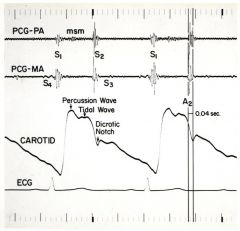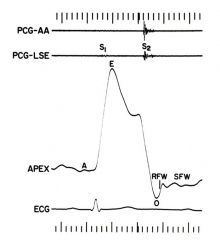![]()
![]()
![]()
Use LEFT and RIGHT arrow keys to navigate between flashcards;
Use UP and DOWN arrow keys to flip the card;
H to show hint;
A reads text to speech;
4 Cards in this Set
- Front
- Back
|
TRUE/FALSE - Since the arterial wave form changes as it moves towards the periphery, the more distal pulses are less useful in detecting changes in left ventricular ejection, stroke volume and aortic valve function
|
True
|
|
|
Percussion Wave = rise due to LV ejection;
Tidal Wave = echo of the percusion wave by the arterial system; Dichrotic notch is the abrupt closure of the aortic valve; dicrotic wave is the reflected wave from the peripheral vasculature |

Describe the carotid pulse. Percussion wave? Tidal Wave? Dichrotic Notch? Dicrotic wave?
|
|
|
a wave = RA contraction;
c wave = tricuspid closure; v wave = passive RA filling; h wave = complete RV filling; x descent = atrial relaxation; x' descent = movement b/c of ventricular contraction; y descent = tricuspid opening |

Since JVP ~ RA, Describe the different parts of an internal jugular vein tracing. a wave? c wave? v wave? h wave? x, x' & y descent?
|
|
|
Small A wave = LA contraction;
rise & fall of E = ventricular ejection; O point = mitral valve opening; RFW = rapid ventricular filling; SFW = slower ventricular filling; |

Describe the Apical Impulse.
A? E? O? RFW? SFW? |

